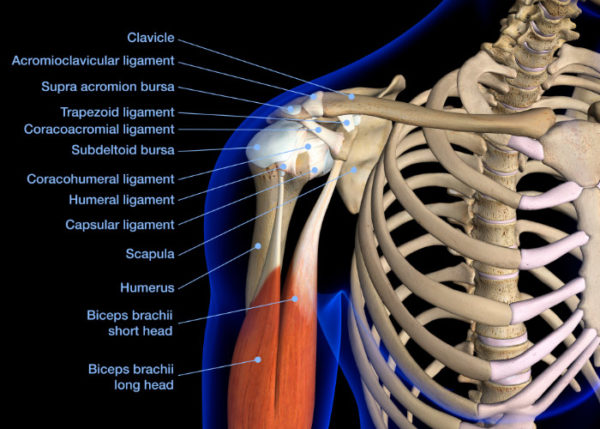Shoulder Expert

The shoulder is a ball and socket joint with a large range of motion. The shoulder is also one of the most complex joints in the body, capable of rotation, lifting, extension and flexion. Common conditions or injuries of the shoulder include shoulder instability, rotator cuff injuries and shoulder dislocations. Shoulder specialist, Doctor Riley J. Williams provides diagnosis as well as surgical and nonsurgical treatment options for patients in Manhattan, Brooklyn, New York City and surrounding areas who have sustained a shoulder injury or are experiencing shoulder pain. Contact Dr. Williams’ team today!
What is the anatomy of the shoulder?
The shoulder is a ball and socket joint which connects the humerus (upper arm), scapula (shoulder blade), and clavicle (collarbone). It is one of the largest joints in the body and is also one of the most complex. The shoulder consists of two main joints, the acromioclavicular joint, and the glenohumeral joint. These two joints work together, allowing for movements such as rotation, extension, flexion, and lifting. Dr. Riley J. Williams, orthopedic shoulder specialist, has years of experience diagnosing and treating patients in Manhattan, Brooklyn, New York City, NY and surrounding areas who have experienced an injury or an unusual condition of the shoulder.
What makes up the shoulder?
The shoulder is a highly complex joint and consists of several bones. These bones include:
- Clavicle: The clavicle attaches the body trunk to the arm. It is an “S” shaped long bone that supports the anterior shoulder and stabilizes the shoulder girdle.
- Scapula: The shoulder blade is a large, flat bone that forms the bulk of the shoulder joint bony anatomy. The scapula is the origin and attachment point for ligaments and muscles that are vital for shoulder function. It has three processes: the acromion process, the spine, and the coracoid process: these act as the muscular attachment points.
- Humerus: the humerus attaches the forearm to the rest of the shoulder. The top of the humerus fits snuggly into the glenoid cavity of the shoulder, making it a ball-and-socket joint, which allows for free movement and rotation of the arm. This ball and socket joint is also called the glenohumeral joint.
These bones come together to form three important joints. The acromioclavicular joint is formed between the scapula and the clavicle. The sternoclavicular joint joins together the clavicle to the breastbone and helps to stabilize the shoulder. Finally, the humerus and the scapula are joined together to form the glenohumeral joint, which is the main joint in the shoulder. Along with the bones, the shoulder has many ligaments that allow for movement and stabilization.

What are other important shoulder structures?
Other important structures that make up the shoulder joint include:
- Glenoid Labrum: a cartilage structure that helps keep the ball-and-socket joint of the shoulder stabilized. The labrum is a stabilizer or bumper for the glenohumeral joint and is responsible for keep the humeral head within the joint socket.
- Rotator cuff: this tendon surrounds the top of the humeral head and is attached to the rotator cuff muscles: subscapularis, supraspinatus, infraspinatus and teres minor. These muscles that stabilize the shoulder socket and allow for facilitate glenohumeral joint movement.
- Bursa: a fluid-filled sac in the joint that reduces friction and allows for smooth movement of the shoulder. The subacromial bursa, when inflamed, can be a source of shoulder pain.
- Articular Cartilage: Covers the ends of the bones and enables the smooth movement of the bones in apposition to one another within the joint.
What common shoulder injuries does Dr. Williams treat?
The shoulder is extremely complex and allows for a large range of motion. Many actions, especially those of athletes in high-impact sports, can cause the shoulder to become injured or damaged. Dr. Riley J. Williams has years of experience diagnosing and treating various shoulder injuries including:
- Biceps tendon tears (proximal and distal)
- Shoulder instability
- Shoulder dislocations
- Labrum and SLAP tears
- Shoulder Impingement
- Rotator cuff injuries
- Clavicle fractures
- Shoulder joint Arthritis
- AC joint separation and arthritis
- Coracoclavicular ligament injuries
The flexibility and range of motion of the shoulder makes this ball and socket joint susceptible to injury. It is important to seek out a specialist who has a proven track record of successfully treating shoulder conditions and injuries. Dr. Williams has an excellent track record and is known as one of the best choices in New York for shoulder treatment.
For more information on shoulder anatomy, or for additional resources on causes of shoulder pain or if you’ve experienced an injury, please contact the office of Riley J. Williams, MD, orthopedic knee surgeon serving Manhattan, Brooklyn, New York City, NY and surrounding areas.
